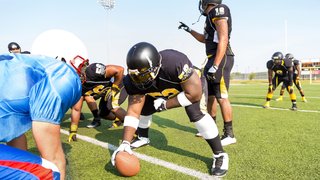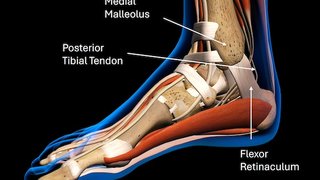Torn rotator cuff: Symptoms, diagnosis, and treatment options
April 14, 2025

What are Rotator Cuff Injuries?
Rotator cuff injuries are often associated with athletes – a star pitcher or quarterback makes headlines because they are scheduled for surgery to repair a tear in their shoulder.
But more often than not, torn rotator cuffs affect carpenters, construction workers, painters, and people in their 40s and older who have worked at jobs where they lift heavy objects and make repetitive overhead arm movements over a long period of time.
Causes of Rotator Cuff Tears
Traumatic rotator cuff tears are caused by sudden, forceful injuries, such as falling or being involved in a vehicle accident. But those injuries are much less common.
Most rotator cuff tears are progressive, beginning as tendinitis or inflammation in the tissue that connects the shoulder muscles to the shoulder joint, helping to stabilize it. Over time, the tissue can split, resulting in a partially or fully torn rotator cuff.
Less than half of patients with full rotator cuff tears report pain, and some may walk around with a torn rotator cuff for 20 years or longer without issues. Then, one day, they wake up with disruptive pain, day and night. In fact, sleep loss is a major reason patients seek care for rotator cuff injuries. When nearly every position puts pressure on the shoulder, it can be difficult to lie down comfortably.
Many patients delay care because they don't want to have surgery. But not every patient needs surgery to repair a torn rotator cuff.
UT Southwestern is one of 17 sites participating in a nationwide clinical trial called ARC (Arthroscopic Rotator Cuff) that will compare outcomes between surgical repairs and physical therapy in hopes of learning which therapies work best for rotator cuff tears and why. We expect this comprehensive research will only enhance our ability to help patients select the best option for treatment and recovery based on their anatomy and functionality goals.
Evaluating the Best Treatment Approach for Torn Rotator Cuff
Currently, the best approach for torn rotator cuff treatment is a close evaluation of your injury, daily activities, and goals. Using this information, we can personalize the most effective, least invasive path to long-term pain management and improved shoulder function. This plan starts with an accurate diagnosis.
How is a Torn Rotator Cuff Diagnosed?
We typically begin assessing most rotator cuff injuries with a physical exam. Your doctor will ask you to make a series of arm movements, which might include:

- Giving yourself a bear hug
- Rotating your arm at a 90-degree angle
- Reaching behind and up your back as far as you can
The goal of the physical exam is to gauge the approximate location and severity of your injury. Patients with a tear that warrants treatment may experience symptoms including:
- Pain when lifting or rotating the affected arm
- Pain when lying on the affected shoulder
- Weakness of the affected arm
- Popping sounds when the arm moves in certain directions
The physical exam also helps us rule out other conditions, such as a pinched nerve or one of these common concerns:
- Rotator cuff tendinitis can occur when you have inflammation of a single tendon, which will produce pain when you make specific movements, such as reaching upwards or even combing your hair.
- Bursitis is another common shoulder condition and it occurs when inflammation spreads into the subacromial bursa, or sac filled with fluid that lubricates the tendons. The pain from this condition is usually worse at night.
If we suspect you have a torn rotator cuff, we'll need to know whether it's a total or partial tear. An MRI exam will allow us to see inside your shoulder and analyze the bone, muscle, and connective tissues.
This information helps us determine what type of treatment might benefit you most. For small to moderate tears, physical therapy may provide adequate relief. Large or irregular tears may require surgery.
What is the Best Treatment for a Torn Rotator Cuff?
The best treatment usually depends on the type of tear and your age. Traumatic rotator cuff tears typically require surgery due to the severity of the injury. However, physical therapy or surgery may work for an atraumatic rotator cuff tear.
Your doctor can help you weigh the pros and cons of your treatment options. In general:
- Consider physical therapy if you:
- Have a mild-to-moderate atraumatic tear
- Are older than 50: While the tear may progress, it is unlikely to do so quickly enough to warrant shoulder replacement surgery.
- Consider surgery if you:
- Have a traumatic tear or a severe atraumatic tear
- Are younger than 50: Research shows that for patients in this age group, 50 percent of tears increase in size within two years.
Research has shown that patients who expect physical therapy to help them have better results than those who expect no benefit. While physical therapy can help decrease pain and improve your range of motion, it won’t heal the tear. A combination of assisted and unassisted range of motion and strength exercises can help strengthen the shoulder muscles and improve flexibility, protecting the tear and potentially preventing it from getting worse.
In advanced cases, physical therapy alone might not be enough to manage pain or prevent further tearing. At this point, patients may need to consider surgery.
Our surgeons treat a high volume of shoulder injuries each year and we are experts in determining the least invasive, most effective treatments to get patients – athletes, professionals, and Average Joes – back to their activities safely and quickly.
If you choose surgery, physical therapy will be an essential part of your recovery. We work closely with our Physical Medicine and Rehabilitation (PM&R) team to personalize care plans for patients with rotator cuff tears. Our therapists and board-certified PM&R doctors will help you achieve the highest physical function possible after surgery.
Related reading: Unraveling the mystery – and misery – of frozen shoulder
Rotator Cuff Repair Surgery: What to Expect
UT Southwestern offers minimally invasive rotator cuff repair surgery, which decreases pain, scarring, and recovery time compared with traditional open surgery. The procedure takes 2 to 2 ½ hours, with an hour or two of recovery afterward. Most patients can go home the same day.
During surgery, the surgeon will insert an arthroscope – a slender tube with a small lens and light attached – through a 1-inch to 2-inch incision in your shoulder. The arthroscope allows us to see inside your shoulder joint and use pencil-sized instruments to remove damaged tissue, repair the tear, and reaffix the connective tissue to the shoulder joint using tiny metal anchors.
Some surgeons perform anchorless repairs to reduce the amount of foreign material left in the bone. Originally done in open surgeries, anchorless repairs are now making their way into arthroscopic surgeries. Here, wire sutures are passed through bone tunnels, then again through the tendon to be knotted around – rather than anchored to – the bone.
Augmented reality shoulder replacement at UTSW
Shoulder specialist Michael Khazzam, M.D., performed the first augmented reality shoulder arthroplasty in Texas in April 2021. UT Southwestern is one of only 15 centers in the world using the advanced technology, which provides increased precision in the OR.
Recovery After Surgery
Most patients will regain a functional range of motion and adequate strength four to six months after surgery.
Recovery begins with short-term immobilization to protect the tendons while they heal. Your surgeon will recommend that you wear a sling and avoid arm movement for up to six weeks.
Next is passive exercise, which begins four to six weeks after surgery. Your physical therapist will support your arm while you move through different positions, personalized to your healing needs. Many patients whose jobs require minimal arm movement can return to work four weeks after surgery.
After four to six weeks, you'll progress to active exercises without assistance from your therapist. These exercises help increase strength and improve control. Between eight and 12 weeks, you will begin your strengthening exercises. If you have a more active job, such as lifting things above your head, you may be advised to wait three or four months to return to work.
The Future of Rotator Cuff Repair
In addition to the ARC clinical trial, we plan to become a site for another study, with funding from the National Institutes of Health, to explore the genetics of rotator cuff tears. Together with Nitin Jain, M.D., M.S.P.H., who leads our Physical Medicine and Rehabilitation team, we hope to learn more about who might benefit from rotator cuff surgery.
Dr. Jain and UT Southwestern are leading the future of healing rotator cuffs without surgery using platelet-rich plasma and stem cell therapies. This field, known as regenerative medicine, builds on the body’s healing capabilities to improve the growth, repair, or replacement of damaged and diseased tissues without invasive procedures.
If shoulder pain is disrupting your sleep or daily activities, visit with a rotator cuff expert at UT Southwestern. We can help relieve your pain and restore your functionality.
To request an appointment, call 214-645-8300 or request an appointment online.











